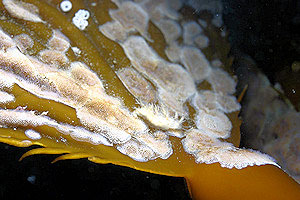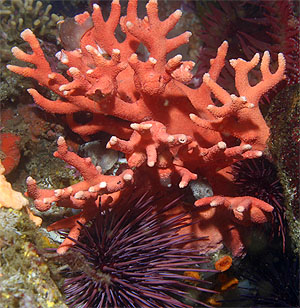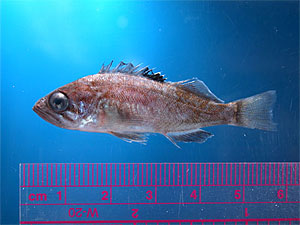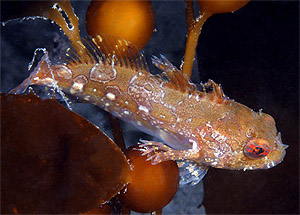
|
|||||||||||||||
|
| |||||||||||||||
The kelp canopy thickens By May, the kelp canopy has becoming quite dense in most areas. With long days, plenty of sunlight, and frequent pulses of nutrients from upwelling events, the giant kelp grows ever more rapidly, and will reach its maximum growth rate of 18-inches a day in June. In order to grow as quickly as it does, giant kelp needs lots of "fertilizer" in the form of nitrate dissolved in the surrounding seawater. Plumes of nitrate-rich water often reach the kelp beds in May and June following upwelling events. To quickly absorb lots of nitrate from the surrounding seawater, giant kelp also needs a steady supply of seawater moving over its blades. The winds, wind-waves, and upwelling currents of May and June provide exactly this kind of water movement. Note: Giant kelp (especially in sheltered coastal areas) grows more slowly in the fall, when the ocean is relatively calm, and there are fewer upwelling events providing nutrients for the kelp. The extent and density of the kelp canopy in May largely depends on how many severe storms occurred during the previous winter. After a mild winter, the canopy may be dense and extensive in May. After a stormy winter, however, there may still only be isolated patches of kelp in many areas. The extent of the kelp canopy also varies considerably from one stretch of coastline to another. In the the most protected coastal areas, such Stillwater Cove, Cannery Row, and Capitola, the kelp canopy may already have reached maximum coverage by May, forming a dense, continuous cover. On the other hand, along the exposed coast outside of Monterey Bay, where the kelp is more likely to sustain serious damage during winter storms, the kelp canopy may still be very thin in May, and may not reach maximum coverage until July or August. Red algae beneath the kelp begin to be shaded out As spring progresses into summer, the kelp canopy becomes so dense that it prevents sunlight from reaching the seafloor. This puts an end to the spring growth spurt put on by many red algae that grow underneath the kelp. Conversely, in areas where the kelp canopy takes longer to recover, more sunlight reaches understory algae, which remain lush and provide a richer habitat, and more hiding places for understory animals. Many animals (bryozoans, nudibranchs, hydroids, limpets) begin to colonize the expanding kelp canopy Many ocean animals attach themselves to "hard" surfaces to resist the buffeting of the waves. Kelp blades, though not "hard," provide attachment surfaces for a wide variety of animals (and other algae). Many of these animals are "kelp specialists" that have unusual adaptions that allow (and in some cases require) them to live on kelp blades. As the kelp canopy begins to expand in May, a number of these specialized animals, which have been drifting around the ocean as tiny larvae, begin to "settle out" onto the newly developing kelp blades. By settling on newly formed kelp blades, these animals claim valuable space for themselves, and maximize the amount of time they will have to develop and reproduce before the kelp is damaged or destroyed by winter storms. Many of these kelp-canopy specialists start to settle out in May, but do not reach peak abundance until fall, by which time they will grow so thick that some of them begin to smother or damage the kelp itself. Bryozoan colonies begin forming  Colony of Membranipora tuberculata bryozoans on a kelp blade. (Source: NOAA/SiMON) Some of the most aggressive colonizers of giant kelp are tiny animals called bryozoans. You can often see the thin, net-like colonies of one common bryozoan, Membranipora membranacea, spreading across the giant-kelp blades that have washed up on a beach. If you look at one of these bryozoan colonies with a hand lens, you will see that it is made up of thousands of tiny, flat "cells." Each cell contains a separate animal, which feeds itself by capturing drifting debris from the passing currents using an array tiny tentacles. All the bryozoans in a particular colony are clones of a single bryozoan larva that landed on that kelp blade and then started reproducing. When a Membranipora larva lands on a blade of kelp, it grows rapidly, forming a new row of cells every 18 hours. If unchecked, a single colony can cover an entire kelp blade in about three weeks. Predatory nudibranchs feed on bryozoans Fortunately for the kelp, several species of nudibranchs (sea slugs) specialize in eating bryozoans. In fact, one tiny nudibranch called Doridaella steinbergae feeds only on Membranipora bryozoans. Even with a good hand lens or microscope, the tiny Doridaella nudibranchs are almost impossible to see. Their bodies are clear except for a delicate pattern of white webbing that looks just like the bryozoans they feed on. Doridaella nudibranchs have an ingenious and effective way of feeding on bryozoans, one cell at a time. First they seal the opening of the cell with slime. Then they use their tongue-like radula to poke a small hole in the cell and suck out their prey. A single Doridaella nudibranch can suck up as many as 150 bryozoan cells a day. Note: Membranipora bryozoans are not entirely at the mercy of these tiny predators. Where Doridaella nudibranchs are present, bryozoans may grow an array of defensive spines. (These "battle-hardened" bryozoans were previously thought to be a separate species). Like the bryozoans themselves, Doridaella nudibranchs must reproduce rapidly to take advantage of the late spring expansion of the kelp canopy (and their bryozoan food supply). Each female nudibranch lays two batches of eggs a day, with up to 2,000 eggs in each batch. After about eight days, these eggs hatch, releasing microscopic larvae. The Doridaella larvae spend several weeks drifting around the kelp beds. Those larvae that survive their wandering will settle onto a bryozoan patch and begin grazing. However, even this part of the nudibranch's life is abbreviated—the adults themselves live only about three weeks! Ostrich-plume hydroids colonize kelp Another colonizer of the kelp-canopy (and the intertidal areas) are Ostrich-plume hydroids (mostly in the genus Obelia). Like bryozoans, the feathery colonies of ostrich-plume hydroids consist of thousands of tiny individual organisms that grow by budding off of one another. Instead of releasing floating larvae, ostrich-plume hydroids release tiny jellyfish-like medusae, which drift around the ocean. In May, thousands of ostrich-plume medusae begin settling out onto kelp blades and other exposed surfaces. When one of these medusae settles on a kelp float, a piling, or a bit of floating debris, it builds itself a tiny chamber and then begins budding off into clones that eventually form a series of feathery plumes that can grow to over six inches long. Typically a number of these feathery plumes grow out from a single attachment point such as a kelp float whose stipe has been torn off. They also colonize pier pilings and drifting bits of driftwood or debris. You can read more about ostrich-plume hydroids on the page about kelp beds in August (August is when ostrich-plume hydroids are most abundant and are actively reproducing). Like the bryozoan colonies, hydroids can eventually damage the kelp they grow on. But like the bryozoans, they have their nemesis—a specific type of nudibranch, Flabellina trilineata, that specializes in devouring ostrich-plume hydroids, and reproduces rapidly once it finds a hydroid colony. Red urchins settle down among kelp holdfasts  Young red sea urchins sheltering underneath a California hydrocoral (Source: Steve Lonhart / SIMoN NOAA) Although bryozoans and other "epifauna" can damage individual kelp blades, the animal that arguably poses the greatest threat to a kelp forest is the red sea urchin (Stronglyocentrotus franciscanus). Young red urchins settle out of the plankton in late spring, and typically gather around kelp holdfasts. On the Central Coast of California red-urchin larvae seem most likely to settle in May or June. One study suggested that a second group of larvae may settle in the kelp during in September. Note: Along the Oregon coast, red sea urchins typically start settling onto the seafloor in June. The red-urchin larvae that settle in the kelp beds during May started out life as eggs and sperm the previous February or March. For two months, these larvae drifted around the open ocean, feeding on spring-bloom diatoms. Most of the time, these red-urchin larvae are carried offshore by upwelling plumes and never make it back to shore to start a new generation. For this reason, it is relatively rare for large numbers of red sea urchins to colonize kelp beds. One marine biologist at Hopkins Marine Lab studied urchins in a kelp bed for ten years and saw no major "recruitment events.". But every so often (more often during El Nino years), shoreward currents carry the larvae back to shore, resulting in a bumper crop of young red sea urchins on the Central Coast. Such "recruitment events" may yield a community of urchins that survives for decades. Note: In Southern California, where upwelling is less common near shore, large numbers of red sea urchin larvae may settle into the kelp beds every year. Newly settled red urchins are tiny—about the size and shape of a pea. Covered with tiny spines, they look like little balls of fuzz nestled among the ropy strands of a kelp holdfast. However, within a few years, they will have grown into voracious six-inch-diameter kelp-eating machines, capable of devouring not only kelp blades, but also the stipes and holdfasts that connect the kelp to the seafloor. Like most living things, young red urchins face a daunting array of hungry predators, including the juvenile rockfish that also colonize the kelp beds in spring. To avoid being eaten, the young red urchins spend most of their time in cracks or crevices. Lacking suitable hiding places, a young red urchin will cozy up underneath an adult of its own kind. In fact, when an adult red sea urchin detects a sun star (a major kelp-bed predator) nearby, it releases a chemical that attracts young red urchins, which huddle together under the adult's three-inch-long spines. Adult red urchins typically range across the open seafloor looking for tasty kelp plants. However, such behavior makes them easy picking for sea otters, who are very fond of red urchins. By keeping red sea urchin populations in check, sea otters are in effect keeping the kelp beds from being devoured. After sea otters returned to the Central Coast in the 1970s, red urchins became scarce, and many kelp beds expanded. Those few red urchins that survived had to spend most of their time hiding deep within cracks, where the dexterous sea otters couldn't reach them. In kelp beds without sea otters, such as those in Southern California, red urchins may reproduce like crazy, forming dense "herds" that devastate the kelp holdfasts. Such herds of urchins can eat up all the kelp, creating "urchin barrens." Once this occurs, the urchins go roaming across the seafloor like feral sheep, looking for whatever food they can find, and competing with other kelp-bed grazers such as abalone. To make matters worse, after red urchins have devastated an entire kelp forest and thus have nothing to eat, they can apparently survive for months with little or no food . Eventually, however, such high-density living apparently makes the urchins susceptible to bacterial infections, which can wipe all the urchins out in a matter of months. On the other hand, a red sea urchin that finds just the right living conditions can survive for well over 100 years! Young winter-spawning rockfish settle into kelp beds In late April or May, small armies of juvenile rockfish move toward shore and colonize the kelp beds. These spring colonizers include two of the most common kelp-bed rockfish--blue rockfish and olive rockfish. Since late winter these young rockfish have been drifting around the offshore waters, first as larvae, and then as dime- to nickel-sized juvenile fish. Blue rockfish settle into kelp beds  Young blue rockfish. (Source: Ammann / NOAA/SIMON) In the Montery area blue rockfish (Sebastes mystinus) in the Monterey Bay region are typically born in late January, and spend at least two months as drifting larvae before returning to the kelp beds in May and June. Note: Blue rockfish near Mendocino are born and return to the kelp beds about three weeks later than those near Monterey, possibly because upwelling starts later along the Mendocino coast. Because of strong northwest winds and currents during April and May, the young blue rockfish may be carried dozens or even hundreds of miles from shore Conversely, during spring seasons when warmer water flowed up the coast from the south (e.g. El Nino years), blue rockfish spent less time drifting, and settled into the kelp beds earlier in the year. .
Note: Some other coastal rockfish, such as yellowtail rockfish, may follow similar patterns as blue rockfish, with larval periods and settlement dates that are directly proportional to the amount of upwelling.
During their time as plankton, the young blue rockfish eat copepods and small krill, as well as other larvae. How they make their way back to shore is anyone’s guess (shoreward moving subsurface currents may play a part).
One way or another, come April or May, swarms of two-inch-long juvenile blue rockfish begin to appear in the kelp canopy, where the rapidly growing kelp blades provide protection from predators.
Blue rockfish often swim in mixed schools together with young olive rockfish and black rockfish. As they mature, the blue rockfish will remain in the kelp canopy, while the olive and black rockfish will settle down toward the seafloor.
When they first settle into the kelp canopy, the young "blue rockfish" are a speckled reddish color. As they mature, they acquire a slaty blue-gray color.
Once settled into the kelp canopy, the juvenile blue rockfish eat copepods and the drifting larvae of intertidal animals such as barnacles, which are carried into the kelp beds by ocean currents. Whenever the northwest winds of spring calm down for a day or two, these currents flow toward shore, carrying clouds of microscopic larvae into the kelp beds, and providing a bounty for the juvenile rockfish.
Blue rockfish are the most common type of rockfish in Central Coast kelp beds, forming very large schools in and just beneath the kelp canopy. Because of their large numbers and habit of eating animals that drift into the kelp beds from offshore waters, blue rockfish form a key ecological link between the open ocean and the kelp beds.
Juvenile rockfish sometimes form such dense schools and eat so many larvae that they affect the abundance of animals in nearby tidepools. One study showed that fifty times more barnacle larvae settled into tidepools where there were no juvenile rockfish in the surrounding kelp beds, compared with areas where juvenile rockfish were abundant.
Young blue rockfish also provide food for many kelp-bed predators, including other rockfish, lingcod, and cabezon, not to mention sharks, dolphins, seals, and sea lions. They are also considered the “bread and butter” of recreational rockfish fishing in Central California.
Blue rockfish seem to be more abundant during years when upwelling is strong and consistent. They also seem to alternate in abundance with gopher rockfish--during years when few blue rockfish are seen, gopher rockfish (which live near the seafloor) are relatively abundant.
As the young blue rockfish grow through the summer and fall, they switch to eating soft bodied, drifting animals such as jellyfish, salps, pelagic snails, and comb jellies (ctenophores), that are carried into the kelp bed by changing ocean currents. They will also supplement their diets by eating kelp spores and red algae, small shrimp, crabs, and fish.
Cabezon settle into kelp beds  Very young cabezon and kelp floats. (Source: Kevin Lee) At the same time as juvenile blue, black, and olive rockfish are settling into the kelp beds, so are the young of several predatory fishes, most notably juvenile cabezon (Scorpaenichthys marmoratus). Like the rockfish, these young cabezon have been floating around the ocean for several months. Like the rockfish, they somehow find their way back to shore at the height of the upwelling season (April to June). Some of the newly settled cabezon hang out in the kelp canopy. Others colonize tide pools, shallow rocky areas, or breakwaters, where there are plenty of nooks and crannies in which to hide. There the young cabezon lurk, waiting to ambush small shrimp, crabs, and amphipods (rock lice). As the cabezon grow larger, they will expand their prey list to include almost any animal that they can get in their mouths, including small crabs, market squid, young octopus, young abalone, snails, small fish (including young rockfishes), and fish eggs. Once they reach about six inches in length, cabezon switch to hunting crabs, which form the majority of their diet as adults. Quintessential "hide and wait" predators, cabezon spend most of their time hiding in holes in rock reefs or tide pools, or hanging motionless beside kelp blades. Their lumpy, spiny bodies and mottled olive green (females) to reddish (males) skin help them blend in with the seafloor algae. At low tide, many cabezon spend their time out in the kelp beds, often favoring a specific patch of kelp or a hole in the rocks. As the tide rises, the cabezon move toward shore and lurk in the dark corners of tide pools. If a crab crawls past, the cabezon opens its mouth, lunges forward, and swallows the animal whole. |
